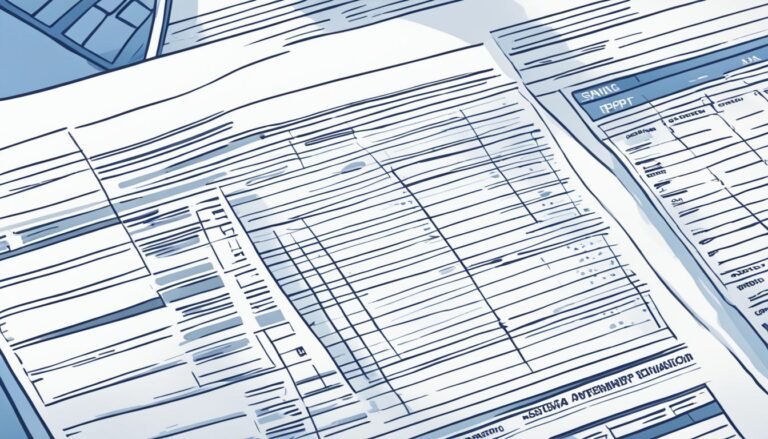Success in Navigating Regulatory Compliance
Did you know that companies around the world spend an estimated $66 billion annually on regulatory compliance? That’s a staggering amount, highlighting the immense importance organizations place on adhering to the legal requirements set by regulatory bodies. Navigating the complex landscape of regulatory compliance is crucial for businesses to avoid penalties, maintain trust, and achieve their compliance goals.
Key Takeaways:
- Regulatory compliance is a critical aspect of business operations, ensuring adherence to laws, regulations, and guidelines.
- Understanding the regulatory landscape and staying updated on regulatory updates and trends is essential for successful compliance. Tools like LexisNexis regulatory compliance software can help streamline this process by providing real-time updates and comprehensive resources, ensuring your organization remains compliant with evolving regulations.
- Identifying compliance risks through risk assessments, policy reviews, and employee training is crucial for mitigating potential issues.
- Developing a comprehensive compliance program and implementing effective policies and procedures is key to achieving regulatory compliance.
- Continuous monitoring, auditing, and improvement are necessary to ensure ongoing compliance and mitigate risks.
Introduction to Regulatory Compliance
Regulatory compliance is the practice of ensuring that an organization follows the laws, regulations, and guidelines set by regulatory bodies. It plays a critical role in business operations, providing a framework for maintaining legal and ethical standards. By adhering to regulatory requirements, organizations can build trust with stakeholders, protect their reputation, and mitigate risks.
In today’s complex business environment, understanding the regulatory landscape is essential for achieving compliance. Different industries are subject to specific regulatory bodies that enforce sector-specific rules and regulations. By familiarizing themselves with these regulatory bodies and the laws that apply to their industry, organizations can develop strategies to navigate the compliance landscape effectively.
One of the primary reasons for compliance is to meet legal obligations. Regulatory bodies set guidelines and enforce regulations to protect consumers, employees, and the environment. Non-compliance can result in severe consequences, such as fines, penalties, lawsuits, and even criminal prosecutions. Additionally, organizations that fail to meet compliance obligations may suffer reputational damage, loss of customer trust, and diminished competitive advantage.
Effective compliance management requires organizations to establish policies, procedures, and controls to facilitate adherence to regulatory requirements. This includes developing compliance programs that define roles and responsibilities, implementing training programs to educate employees on compliance obligations, and establishing monitoring and auditing processes to identify and address any compliance gaps.
Overall, regulatory compliance serves as a foundation for ethical business practices and helps organizations operate in a responsible and sustainable manner. By prioritizing compliance and staying updated on regulatory changes, organizations can build a culture of integrity and ensure long-term success in a highly regulated business environment.
In the next section, we will delve into understanding the regulatory landscape and the key regulatory bodies that organizations should be aware of.
Understanding the Regulatory Landscape
The regulatory landscape plays a crucial role in shaping the operations of businesses across industries. As regulations continue to evolve, organizations must stay updated and navigate the intricate maze of compliance requirements effectively. By understanding the regulatory landscape, businesses can proactively adapt their strategies and ensure compliance with key regulatory bodies such as the SEC, EPA, OSHA, and FTC.
Staying Informed and Adapting to Change
The pace of regulatory change can be overwhelming, making it vital for organizations to stay informed about the latest updates and trends. This enables businesses to anticipate regulatory shifts and respond accordingly. Regularly monitoring official channels and industry-specific publications can provide valuable insights into regulatory changes that impact your operations.
For example, in the financial industry, staying updated on the guidelines and requirements set by the Securities and Exchange Commission (SEC) is crucial for maintaining compliance and ensuring the security of client assets.
Collaborating with Legal and Compliance Experts
Seeking legal counsel and compliance expertise is paramount for organizations aiming to navigate the regulatory landscape effectively. Industry-specific legal and consulting firms can provide guidance on compliance strategies and help address any grey areas or uncertainties. Their expertise can prove invaluable in interpreting complex regulations and establishing compliant practices.
Developing a Compliance Plan
Organizations must develop a comprehensive compliance plan to align their operations with the regulatory landscape. This plan should outline compliance goals, establish processes, and designate responsible individuals or teams to ensure accountability. By formalizing compliance procedures, organizations can minimize compliance risks and focus on achieving regulatory objectives.
Building Relationships with Regulatory Bodies
Establishing positive relationships with regulatory bodies can foster open communication channels and facilitate compliance efforts. Proactively engaging with regulators can help organizations gain insights into upcoming changes, seek clarifications, and collaborate effectively. Building trust and mutual understanding with regulatory bodies can greatly contribute to a smoother regulatory compliance journey.
Implementing Technological Solutions
Adopting compliance management software and data analytics tools can streamline the compliance process and enhance efficiency. These technologies can automate repetitive tasks, provide real-time monitoring of compliance activities, and generate reports for audits and regulatory submissions. Implementing technology solutions can significantly simplify compliance efforts and reduce the risk of human error.
| Key Takeaways |
|---|
| Stay updated on regulatory changes impacting your industry. |
| Collaborate with legal and compliance experts to ensure compliance. |
| Develop a comprehensive compliance plan to guide operations. |
| Build relationships with regulatory bodies to foster effective communication. |
| Implement technology solutions to streamline compliance processes. |
Identifying Compliance Risks
Compliance risks are a constant concern for businesses as they pose potential violations of laws, regulations, and policies, which can result in severe legal, financial, and reputational consequences. Identifying these risks is crucial in order to proactively mitigate potential issues and ensure compliance with regulatory requirements.
Conducting Risk Assessments
To effectively identify compliance risks, organizations can conduct comprehensive risk assessments. These assessments involve evaluating the existing processes, systems, and operations to identify any potential gaps or vulnerabilities. By conducting thorough assessments, businesses can have a clear understanding of the specific areas that may pose compliance risks and take appropriate actions to address them.
Reviewing Regulations and Policies
Staying updated with the latest regulations and policies relevant to the industry is essential for identifying compliance risks. Regularly reviewing and monitoring changes in regulations and policies enables businesses to identify any gaps or non-compliance issues within their operations. It is crucial to have a robust compliance management system in place to track and assess regulatory changes and ensure timely compliance.
Analyzing Past Incidents
Learning from past incidents and compliance breaches can provide valuable insights into potential risks. Conducting thorough investigations and analyzing the root causes of past incidents can help businesses identify patterns and vulnerabilities that may expose them to compliance risks. By learning from these incidents, organizations can implement corrective actions and prevent similar violations from occurring in the future.
Providing Employee Training
Employees play a critical role in ensuring compliance with laws, regulations, and policies. Providing comprehensive training programs to employees helps raise awareness about compliance obligations and potential risks. By educating employees about the importance of compliance and providing them with the necessary knowledge and skills, businesses can mitigate compliance risks associated with human error or lack of awareness.
“Identification of compliance risks is a crucial step in maintaining regulatory compliance and safeguarding the organization from potential legal and reputational consequences.”
| Common Compliance Risks | Potential Consequences |
|---|---|
| Lack of data privacy measures | Data breaches, fines, loss of customer trust |
| Failure to adhere to environmental regulations | Fines, reputational damage, legal action |
| Non-compliance with financial reporting requirements | Fines, legal penalties, loss of stakeholder confidence |
| Violating workplace safety regulations | Employee injuries, legal liabilities, damaged reputation |
By utilizing these strategies, organizations can effectively identify compliance risks and take proactive measures to ensure adherence to regulatory requirements. Remember, compliance risk identification is an ongoing process that requires continuous monitoring and evaluation to adapt to the ever-changing regulatory landscape.
Developing a Compliance Program
A compliance program is a crucial component of regulatory compliance. Developing and implementing an effective compliance program is essential for organizations to meet regulatory requirements, minimize risks, and maintain a culture of compliance.
When developing a compliance program, there are several key elements that should be considered and implemented:
1. Policies and Procedures
Developing comprehensive policies and procedures is the foundation of a compliance program. These documents outline the expectations, standards, and guidelines that employees must follow to ensure compliance with relevant laws and regulations.
It is important to create policies and procedures that are clear, concise, and easily accessible to all employees. Regular reviews and updates should be conducted to ensure they align with any changes in regulations or industry best practices.
2. Training and Education
Providing training and education is essential to ensure that employees have a thorough understanding of their compliance responsibilities. Training programs should cover relevant laws, regulations, company policies, and procedures.
It is important to customize training materials to the specific needs and roles of employees. Regular training sessions, workshops, and online modules can be utilized to reinforce compliance knowledge and promote a culture of compliance within the organization.
3. Communication and Reporting
Establishing effective channels of communication and reporting is crucial for employees to raise concerns, ask questions, and report potential compliance issues. Encouraging an open-door policy and providing anonymous reporting mechanisms can help create a transparent and ethical work environment.
Regular communication updates, such as newsletters, intranet articles, and compliance alerts, can also enhance awareness of compliance requirements and reinforce the organization’s commitment to compliance.
4. Risk Assessment and Monitoring
Conducting regular risk assessments is an important part of developing a compliance program. Identify and prioritize potential compliance risks based on the organization’s industry, operations, and regulatory environment.
Implement effective monitoring systems and controls to detect potential compliance violations. This can include regular audits, self-assessments, data analytics, and internal reporting mechanisms.
5. Continuous Improvement and Review
A compliance program should be reviewed and updated regularly to ensure its effectiveness and alignment with regulatory changes. Conduct periodic evaluations to identify areas for improvement and implement necessary updates.
Continuous improvement is an ongoing process that involves learning from past experiences, benchmarking against industry best practices, and staying updated on regulatory developments.
By developing a robust compliance program that incorporates these key elements, organizations can mitigate compliance risks, ensure regulatory adherence, and promote a culture of ethics and integrity.
| Key Elements of a Compliance Program |
|---|
| Policies and Procedures |
| Training and Education |
| Communication and Reporting |
| Risk Assessment and Monitoring |
| Continuous Improvement and Review |
Implementing Compliance Policies and Procedures
Once a compliance program is developed, it is crucial to effectively implement compliance policies and procedures within your organization. This section will provide valuable insights and guidance on how to successfully implement these policies and procedures, ensuring that your organization meets regulatory requirements and mitigates potential risks.
Firstly, it is essential to clearly communicate the compliance policies and procedures to all employees. This can be done through training sessions, employee handbooks, and regular communication channels. By ensuring that every employee understands their roles and responsibilities in relation to compliance, you can establish a culture of compliance throughout your organization.
Additionally, providing employees with the necessary resources and tools to comply with regulatory requirements is crucial for successful implementation. This may include technology solutions, such as compliance management software, that streamline compliance processes and track and monitor compliance activities. By investing in the right resources, you can effectively manage compliance risks and ensure ongoing adherence to regulations.
In order to evaluate the effectiveness of the implemented compliance policies and procedures, regular monitoring and auditing are necessary. This allows you to identify any gaps or weaknesses in your compliance program and take appropriate corrective actions. By continuously monitoring and evaluating compliance activities, you can maintain a proactive approach to compliance and make necessary improvements to your policies and procedures.
Key Steps for Implementing Compliance Policies and Procedures:
- Communicate policies and procedures clearly to all employees
- Provide necessary resources and tools for compliance
- Regularly monitor and audit compliance activities
- Take corrective actions and continuously improve policies and procedures
By following these steps and implementing compliance policies and procedures effectively, your organization can ensure regulatory compliance and reduce the risk of penalties and reputational damage. Compliance should be integrated into everyday operations, and employees should be empowered to prioritize compliance in their roles.
Training and Education
Employee training and education play a critical role in achieving regulatory compliance within an organization. It is essential to train employees on the specific requirements and regulations relevant to their roles and functions. By equipping them with the necessary tools and resources, organizations can ensure that their workforce is well-informed and capable of complying with regulatory standards.
Regular training sessions not only reinforce the importance of compliance but also help identify potential risks and challenges. Through interactive workshops, online modules, and informative seminars, employees can gain a deeper understanding of the compliance landscape and stay up-to-date with the latest regulatory updates and trends.
Additionally, comprehensive compliance training programs can provide employees with the knowledge and skills to navigate legal requirements effectively. By enhancing their understanding of regulatory frameworks and best practices, employees can contribute to the overall compliance efforts of the organization.
Moreover, employing a variety of training methods, such as on-site workshops, e-learning platforms, and industry-specific certifications, enables organizations to cater to different learning styles and preferences. This ensures maximum engagement and knowledge retention among employees, leading to a more compliant and informed workforce.
Benefits of Employee Training and Education:
- Improved awareness and understanding of regulatory compliance requirements.
- Enhanced ability to identify and mitigate compliance risks.
- Increased efficiency in complying with legal obligations.
- Enhanced reputation and trust among key stakeholders.
- Reduced likelihood of compliance violations and penalties.
Effective compliance training doesn’t just check a box; it empowers employees with the knowledge and skills necessary to uphold regulatory standards and maintain organizational integrity.
Furthermore, training and education should be an ongoing process, with regular refreshers and updates to keep employees informed about any changes in regulations and compliance requirements. By fostering a culture of continuous learning and improvement, organizations can minimize the risk of non-compliance and proactively address potential challenges.
Alongside training initiatives, organizations can also provide access to educational resources, such as industry publications, regulatory updates, and relevant case studies. This enables employees to stay informed about the latest developments in their respective fields and make informed decisions in line with regulatory expectations.
Ultimately, investing in comprehensive training and education programs demonstrates a commitment to achieving and maintaining regulatory compliance. By empowering employees with the knowledge and skills they need, organizations can foster a compliant culture and mitigate potential risks.
Monitoring and Auditing Compliance
Continuous monitoring and auditing of compliance activities are crucial to ensuring ongoing compliance with regulatory requirements. By regularly reviewing policies and procedures, conducting employee training, and assessing the effectiveness of compliance controls, organizations can effectively monitor and audit their compliance efforts.
One essential aspect of monitoring and auditing compliance is the review of policies and procedures. Regularly assessing and updating these documents helps ensure that they align with current regulatory requirements. It also provides an opportunity to identify any gaps or areas for improvement. By keeping policies and procedures up-to-date, organizations can maintain a strong foundation for compliance.
Employee training is another critical component of monitoring and auditing compliance. Regular training sessions enable organizations to educate employees about regulatory requirements and the importance of compliance. It also allows for the identification of areas where additional training or reinforcement may be needed. By providing ongoing education, organizations can empower their employees to make informed decisions that uphold compliance.
The effectiveness of compliance controls should also be evaluated through monitoring and auditing activities. This involves assessing the design, implementation, and operation of controls to ensure their adequacy and effectiveness in preventing and detecting non-compliance. Regular audits can identify control weaknesses and provide recommendations for improvement, enabling organizations to strengthen their compliance measures.
“Monitoring and auditing are essential components of a robust compliance program. By regularly reviewing policies and procedures, conducting employee training, and assessing the effectiveness of compliance controls, organizations can proactively address any compliance gaps and minimize the risk of non-compliance.”
Benefits of Monitoring and Auditing Compliance
Monitoring and auditing compliance offer several benefits to organizations:
- Identification of compliance gaps and areas for improvement
- Enhanced risk management and mitigation
- Detection of non-compliance issues before they escalate
- Strengthened compliance culture and employee awareness
- Increased stakeholder trust and confidence
By regularly monitoring and auditing compliance, organizations can proactively identify and address potential compliance issues. This helps them maintain a strong compliance posture, protect their reputation, and avoid costly penalties or legal consequences.
Best Practices for Monitoring and Auditing Compliance
To ensure effective monitoring and auditing of compliance, organizations should consider the following best practices:
- Establish clear monitoring and auditing objectives and goals.
- Develop comprehensive audit plans that cover all relevant areas of compliance.
- Utilize technology solutions, such as compliance management software, to streamline monitoring and auditing processes.
- Assign dedicated compliance professionals or teams to oversee monitoring and auditing activities.
- Regularly communicate and report on monitoring and auditing findings to senior management and relevant stakeholders.
- Continuously improve monitoring and auditing practices based on lessons learned and industry best practices.
By adopting these best practices, organizations can establish a robust monitoring and auditing framework that effectively supports their compliance efforts.
| Key Components of Monitoring and Auditing Compliance | Benefits |
|---|---|
| Regular review of policies and procedures | Ensures alignment with regulatory requirements and identifies areas for improvement. |
| Ongoing employee training and education | Enhances compliance awareness and empowers employees to make informed decisions. |
| Assessment of compliance control effectiveness | Identifies control weaknesses and provides recommendations for improvement. |
By incorporating these key components into their compliance monitoring and auditing activities, organizations can strengthen their overall compliance program and mitigate the risk of non-compliance.
Responding to Compliance Issues and Violations
Despite the implementation of rigorous preventive measures, compliance issues and violations may still occur within organizations. When faced with such situations, it is crucial to have a well-defined plan in place to effectively respond to and address these challenges. By taking immediate action, organizations can mitigate potential damage, maintain trust, and ensure ongoing compliance.
When responding to compliance issues and violations, the following steps should be considered:
- Identify the Issue: The first step is to identify the compliance issue or violation that has occurred. This can be done through internal reporting mechanisms, employee feedback, or system alerts.
- Assess the Impact: Once the issue is identified, it is important to assess its potential impact on the organization. This includes determining the extent of the violation, any related risks, and the potential consequences.
- Document and Report: It is crucial to document all relevant details surrounding the compliance issue or violation. This includes gathering evidence, interviewing involved parties, and maintaining a record of all actions taken.
- Notify Appropriate Parties: Depending on the severity of the issue, relevant stakeholders should be notified. This may include senior management, legal counsel, compliance officers, or regulatory authorities.
- Remediation and Corrective Actions: Once the issue has been assessed and reported, prompt action should be taken to rectify the situation. This may involve implementing corrective measures, revising policies and procedures, and providing additional training to employees.
- Communicate and Educate: Transparent communication is vital in restoring trust and maintaining compliance culture. Both internal and external stakeholders should be informed of the actions taken to address the issue and prevent its recurrence. This can be done through written communications, training sessions, or public statements.
- Monitor and Prevent Recurrence: To avoid similar compliance issues in the future, organizations should establish monitoring mechanisms to detect and prevent similar violations. This may involve enhanced internal controls, regular audits, and ongoing employee education.
By following these steps, organizations can demonstrate their commitment to integrity and compliance. Swift and effective responses to compliance issues and violations not only help protect the organization but also contribute to a culture of ethical conduct and sustained regulatory compliance.
| Benefits of Effective Compliance Issue Response | Actions |
|---|---|
| 1 | Prevent legal and financial consequences |
| 2 | Maintain trust with stakeholders |
| 3 | Protect brand reputation |
| 4 | Improve overall compliance culture |
As Richard Branson once said, “Complexity is your enemy. Any fool can make something complicated. It is hard to make something simple.” By simplifying and streamlining the response process, organizations can navigate compliance issues and violations with greater efficiency and effectiveness.
Continuous Improvement in Compliance
In today’s rapidly changing regulatory landscape, continuous improvement in compliance is crucial for organizations to stay ahead of evolving regulations and mitigate the risks of non-compliance. By embracing a proactive approach to compliance management, companies can not only meet their regulatory obligations but also gain a competitive advantage and enhance their reputation.
To achieve continuous improvement, organizations must stay updated on regulatory changes and trends that affect their industry. This necessitates a robust strategy for monitoring and analyzing regulatory updates from relevant regulatory bodies, as well as industry publications and news sources. By closely monitoring developments, organizations can proactively identify changes in laws, regulations, or industry standards, and adapt their compliance practices accordingly.
Staying Updated on Regulatory Changes
One effective way to stay updated on regulatory changes is by leveraging technology solutions such as compliance management software and data analytics tools. These tools can automate the process of tracking and analyzing regulatory updates, enabling organizations to quickly identify any changes that may impact their compliance obligations. Additionally, compliance management software can provide real-time reporting and analytics capabilities, helping organizations to assess their compliance status and identify areas for improvement.
Another strategy is to engage with industry associations, trade groups, or regulatory compliance consulting services that provide insights and updates on regulatory changes specific to your industry. Networking with industry peers and attending relevant conferences or webinars can also provide valuable information on emerging regulatory trends and best practices.
Implementing Feedback Loops
Feedback loops play a vital role in continuous improvement in compliance. By collecting feedback from employees, stakeholders, and customers, organizations can gain valuable insights into their compliance efforts and identify areas for enhancement. These feedback loops can take the form of surveys, compliance audits, or regular compliance meetings, where participants can share their experiences, observations, and suggestions for improvement.
By actively seeking feedback and involving key stakeholders in the compliance process, organizations can foster a culture of continuous improvement and adapt their compliance strategies to address emerging risks and challenges.
“Continuous improvement is not just about complying with regulations; it’s about nurturing a compliance culture that seeks to constantly enhance our understanding and practices to meet the evolving expectations of regulators and stakeholders.”
– Jane Thompson, Compliance Officer at ABC Corporation
Gathering and Analyzing Compliance Data
Data analytics can be a powerful tool in identifying compliance trends, patterns, and potential areas of improvement. By collecting and analyzing relevant compliance data, organizations can gain deeper insights into their compliance performance and make data-driven decisions to enhance their compliance programs.
For example, organizations can analyze compliance incident reports to identify common compliance issues and develop targeted training programs to address these areas of concern. They can also track and monitor key compliance indicators, such as the number of compliance audits conducted, the percentage of employees completing compliance training, and the effectiveness of control measures.
| Key Compliance Indicators | Target | Actual | Variance |
|---|---|---|---|
| Number of compliance audits conducted | 4 per quarter | 4 per quarter | No variance |
| Percentage of employees completing compliance training | 95% | 92% | -3% |
| Effectiveness of control measures | 80% | 85% | +5% |
By regularly reviewing and analyzing compliance data, organizations can identify trends, benchmark their performance against industry standards or internal goals, and make informed decisions to continually enhance their compliance programs.
Embracing a Culture of Continuous Learning
Continuous improvement in compliance can only be achieved when organizations foster a culture of continuous learning. This involves providing regular compliance training and educational resources to employees, ensuring they are aware of the latest regulatory requirements and best practices. Compliance training can cover a range of topics, including ethics, data privacy, anti-money laundering, and workplace safety.
Furthermore, organizations can encourage employees to actively participate in compliance initiatives, share their experiences and knowledge, and contribute to the development of compliance processes. Recognizing and rewarding employees who demonstrate exceptional compliance practices can also reinforce a culture of continuous improvement.
Overall, continuous improvement in compliance requires ongoing dedication and investment. By staying updated on regulatory changes, implementing feedback loops, gathering and analyzing compliance data, and embracing a culture of continuous learning, organizations can navigate the complexities of regulatory compliance effectively and maintain a strong compliance posture.
Conclusion
Navigating regulatory compliance successfully is critical for organizations to mitigate legal and financial risks while maintaining customer trust. By diligently understanding the regulatory landscape, identifying compliance risks, developing comprehensive compliance programs, implementing effective policies and procedures, providing consistent training and education, monitoring and auditing compliance activities, and continuously improving compliance efforts, organizations can achieve the desired level of regulatory compliance.
Thriving in regulatory compliance requires dedication, ongoing investment, and a proactive approach. It is an iterative and evolving journey that demands staying abreast of regulatory updates and emerging trends. Leveraging technology solutions, such as compliance management software and data analytics tools, can enhance compliance activities by streamlining processes, identifying potential risks, and improving overall compliance effectiveness.
Ultimately, the benefits of successful regulatory compliance are invaluable. Organizations that prioritize and excel in regulatory compliance not only avoid legal and financial penalties but also strengthen their reputation, build customer loyalty, and gain a competitive edge in their industry. By committing to a culture of compliance and continuously advancing compliance practices, organizations can ensure long-term success in navigating the complex world of regulatory compliance.







